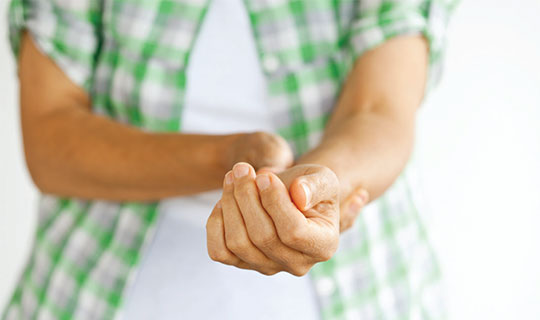
An Orthopedist Can Identify the Cause, and Make Your Next Steps Easier
Pain in the joints can greatly affect quality of life. “Many of our patients tell us they think more about their pain than about the activity they’re doing, even if it’s just walking across the room,” says Frank Liporace, MD, Director of the Orthopedic Institute at Jersey City Medical Center (JCMC). The first step in successful treatment, he says, is to determine exactly what is causing the pain. Because of the wide range of possibilities—from arthritis to bone changes to a malformation of the joint—it’s a good idea to get any joint pain evaluated by specialists. “Come to us to decipher the cause and help you begin the right treatment,” says Dr. Liporace.
ABCs of arthritis
Often, the cause of joint pain is arthritis, a condition that is the major cause of disability for adults in the U.S., according to the Arthritis Foundation. In fact, there are over 100 types of arthritis, and a variety of risk factors and treatments. The most common form is osteoarthritis (OA), also called “wear and tear” or “degenerative” arthritis.
Causes include excess weight, past joint injury or overuse of the joint. The smooth cartilage between the joint breaks down, leading to damage and pain. The pain can lead people to forego being active, which then leads to weaker, less stable muscles around the joint—and more pain. One of the most painful types, rheumatoid arthritis (RA), has a very different cause. It’s an autoimmune disease, which means the body’s immune system attacks healthy cells.
With RA, this attack is to the joints, causing swelling and pain. If not treated early or correctly, the inflammation can sometimes cause permanent damage. Other types of arthritis include psoriatic arthritis (which affects some people with the skin condition psoriasis) and juvenile arthritis (affecting children), both of which are also autoimmune disorders. In addition, arthritic conditions that cause joint pain include many that people do not associate with arthritis, such as lupus and scleroderma (“hard skin”), which are also autoimmune diseases, and gout (a buildup of uric acid crystals in the joint). For patients with a type of arthritis that affects many parts of the body, a range of specialists at JCMC work together to provide the latest treatments to help slow damage and relieve pain.
Treatment options
“Surgery isn’t the only way to treat arthritis pain and other joint pain, and it’s actually the last,” says Dr. Liporace. “Many of our patients have success with a combination of medicines to reduce the pain and inflammation, plus physical therapy.” Pain management involves a combination of medicines taken by mouth or injected using a needle.
Physical therapy treatment focuses on muscle-strengthening, with the goal of helping the patient regain balance and increase the strength of key muscles that support the joint. Other treatments, like surgery, are also effective for some patients, Dr. Liporace says.
“The expertise of our team at the Orthopedic Institute at JCMC spans the range of care, to meet all the needs patients would have,” he says. “Our patients report returning to playing sports, to being more active with their kids and grandkids and to new activities they avoided before because of pain,” he says. “At the end of the day, I’m most gratified when someone has told me, ‘I’m happy how treatment turned out, and I wish I’d done this sooner.’ “Whether you’re age 45 or 85 and have arthritis, we want you to not have to think about your joints at all. We want you to be as active as possible.”
When is it time for joint surgery?
“If a doctor recommends surgery as the first treatment for arthritis or joint pain, you’ve got the wrong doctor,” says orthopedic surgeon Frank Liporace, MD, Director of the Orthopedic Institute at Jersey City Medical Center (JCMC). “We can have a serious discussion about surgery after you have exhausted other options, like physical therapy and medicines.” When surgery is the best option, patients are pleased to find how quickly they improve with advanced treatments, he says.
For example, in a same-day procedure, specialists at JCMC can repair damage or injury to joints with arthroscopy, which involves tiny incisions and the use of small cameras, lasers and other tools. For bones or joints that are not aligned correctly, surgeons can employ other advanced tools and techniques. These include osteotomy, the cutting or removal of a piece of bone, and total joint replacements. “Because of our experience and the techniques, even with total knee replacement, our patients are usually back on their feet in less than a day,” says Dr. Liporace. “They are often surprised and pleased by that.”
To learn more about the Orthopedic Institute at Jersey City Medical Center, call: 844.63.ORTHO.